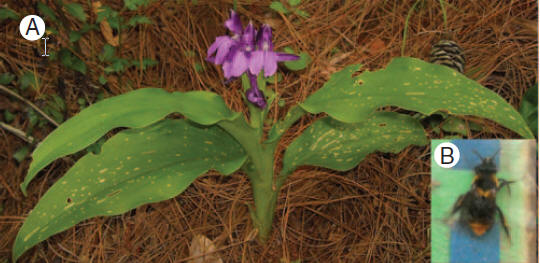Delayed selfing is the predominant mode of autonomous self-pollination in flowering plants. However, few delayed selfing mechanisms have been documented. Dr. FAN Yongli and his supervisor Prof. LI Qingjun of Xishuangbanna Tropical Botanical Garden (XTBG) conducted a study to explore a new delayed selfing mechanism induced by stigmatic fluid in Roscoea debilis, a small perennial ginger.
They reported a new non-anther-stigma contact delayed selfing mechanism in Roscoea debilis (Zingiberaceae), in which the stigma continuously secretes fluid, forming a large globule on the stigma cup on the third day of flowering. The large globule penetrates the nearby pollen grains on the fourth flowering day, inducing pollen grain germination and elongation of the pollen tubes into the stigma.
Their preliminary observations revealed that R. debilis received few pollinator visits during peak blooming times, and they were consequently intrigued by how the species produced a high fruit-set.
In the study, they focused primarily on the following questions: (1) Does R. debilis have the ability to fertilize itself? (2) How and when does self-pollination occur in this species? (3) Why is autonomous selfing favoured in R. debilis?
They surveyed floral biology and flower visitors; evaluated capacity of autonomous selfing by pollinator exclusion; estimated timing of autonomous selfing by emasculation at different flowering stages; and assessed the number of seeds produced from insect-pollination by emasculation and exposure to pollinators in the natural population. They also tested the breeding system by pollination manipulations.
The study documented a previously unknown mechanism of delayed self-pollination. At the end of the window for pollination, stigmatic fluid formed a large globule and then seeped into the nearby pollen grains, inducing pollen germination and pollen tube elongation into the style. The process provides reproductive assurance in Roscoea debilis when pollinator service is limited.
The study entitled “Stigmatic fluid aids self-pollination inRoscoea debilis(Zingiberaceae): a new delayed selfing mechanism” has been published online in Annals of Botany, doi:10.1093/aob/mcs169

(A) Roscoea debilis in the field. (B) A yellow carpenter bee (Xylocopa confusa) caught while visiting flowers of R. debilis (Images by FAN Yongli)

